Seattle event starts strong with deep dives into production, pandemic impacts, marketing and more
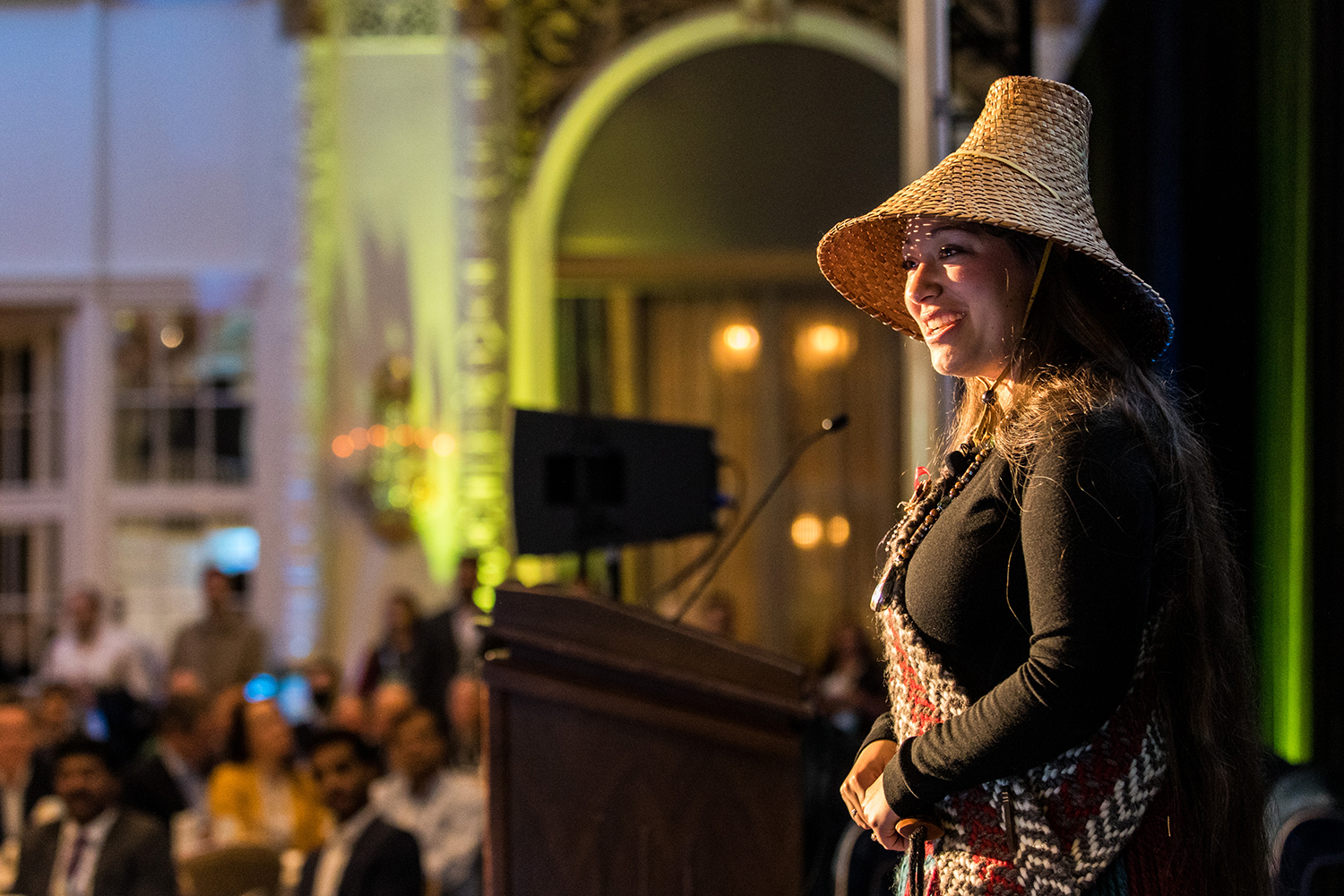
On a busy first day of the Global Seafood Alliance’s annual event, GOAL: The Responsible Seafood Conference, a diverse range of speakers with varied backgrounds and areas of expertise discussed seafood supplies (both wild and farmed), social license, social media marketing and gender equality, among other topics.
Seattle Mayor Bruce Harrell delivered the welcoming remarks and said the city was the perfect place for the conversations being held about key issues facing the industry.
“There is some secret sauce here. We’re forward-looking. We’re not afraid of difficult conversations,” he said, before telling the audience of approximately 350 that they should be “extremely prideful” about working in seafood and that everyone should take the time during the conference to talk to someone “who doesn’t look like you.” Harrell, whose heritage is both Japanese and Black, noted that he is only the second person of color to become the mayor of Seattle.
Diversity, equity, justice and respect were indeed running themes throughout the day. Keynote speaker Loni Grinnell Greninger, the Vice Chairwoman of the Jamestown S’Klallam Tribal Council, said in her keynote address that regardless of demographics, everyone in the room shared a common cause.
“We all have different roles. Every role matters. It starts with the creator. The air, the sun and the water drive growth on the Earth. We’re all here doing the same work, maybe we just call it something different,” she said. “We have a sacred duty to protect and steward our resources. As we steward the Earth, it in turn gives us what we need.”
Grinnell Greninger is the daughter of the late Kurt Grinnell, who championed salmon aquaculture as part of the tribe’s treaty rights. She said that aquaculture is in her people’s “veins.”
“Growth and development, we’re here for it. But we want to make sure we’re taking care of our resources,” she said. “Western science was good to us and we use it to blend in with our own culture values. Aquaculture is our business; it helps us establish food sovereignty and sustainability.”
How an iconic restaurant survived the pandemic
Bob Donegan, CEO of Ivar’s Seafood Restaurants, told the story of the company’s history and how its founder, Ivar Haglund, made the waterfront restaurant a Seattle icon. Its Acres of Clams restaurant – along with its numerous other regional locations – faced an existential challenge a little over two years ago when the Covid-19 pandemic reared its head.
In mid-2020, 189,000 workers in the city applied for unemployment assistance, he said, and Ivar’s had to lay off many of its employees in September of that year. “September 27 was one of the hardest days of my life,” said Donegan.
But the restaurant survived the worst of the pandemic and is back to its old thriving ways. Ivar’s, which is known for its chowder, leaned on its values, starting with its employees.
Donegan listed 10 tips that the seafood restaurant used to weather the storm: good customer service starts with happy employees; hire enthusiasm, train for skills; don’t let good employees leave; recognize their successes; do the research to know your customers well; focus on the food, which for Ivar’s is always fresh, local, wild and sustainable; talk to your customers in as many ways as possible; know the lifetime value of a customer or guest; make your vendors your partners; and create fun.
Donegan said that Ivar’s issued loans to employees to narrow the gap between their previous incomes to their newfound situations with unemployment assistance and then forgave the loans if the workers opted to return to the restaurant, which reopened in May 2021.
“We appear to have survived Corona,” said Donegan.
Birthed in Alaska
Allan Kimball, senior executive consultant for Trident Seafoods and a Global Seafood Alliance board member, spoke about the Responsible Fisheries Management certification program and how Alaska manages its fisheries so successfully.
RFM, which Kimball said was “birthed in Alaska” through the work of the Alaska Seafood Marketing Institute and is now 10 years old, has certified 10 fisheries covering 29 species and is a global effort that encompasses Iceland, Norway, Japan and the EU.
Several wild-capture fisheries certification programs are now benchmarked by GSSI (Global Sustainable Seafood Initiative), but Kimball noted that RFM “was the first.” Through strategic collaborations and outreach, RFM’s goal is to continue building awareness of the program and the issues at hand with suppliers, retailers and foodservice operators and to increase the number of chain-of-custody certifications, which do not include logo licensing fees, Kimball was keen to note.
“All of our obligations are the be protectors of the resource,” said Kimball. “Working with certifications that are valid and have the right incentives is what I’m excited about.”
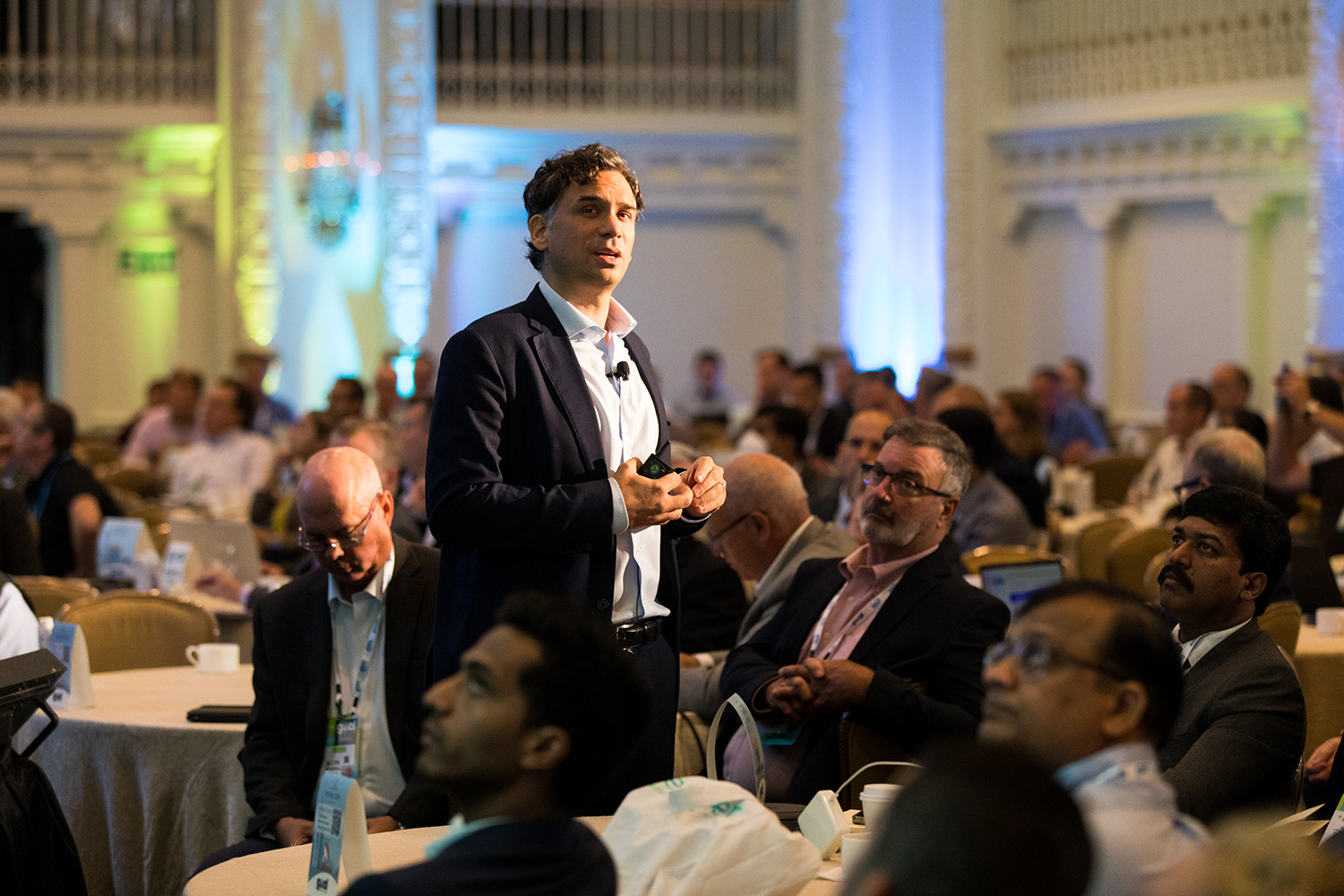
Production survey and forecast
Gorjan Nikolik, senior analyst at Rabobank, delivered the results of the annual Global Aquaculture Production Survey and Forecast, an annual feature of the GOAL conference. Data was shared with GSA and Rabobank from expert sources around the world, and Nikolik noted that this year’s data set was the most robust to date.
Some key findings from the survey:
- Farmed salmonids are having a “bit of a slow year,” said Nikolik, highlighting negative growth in some parts of the sector this year for the first time since 2016. “It helps to explain the high prices” for Atlantic salmon, he added. While Iceland is proving to be a major new growth area for salmon, other species like rainbow trout and coho salmon are going through some volatility, up one year and down the next. For coho, primarily farmed in Chile, supplies are up 15 percent this year but are forecast to decline 14 percent next year.
- Sea bass and sea bream, predominantly produced in Turkey and Greece, are both growing but at different rates. In Turkey, supplies in 2020 were up 11.6 percent from a decade prior and should expect about 3 percent annual growth this year. Greece, which grew its production by 1.2 percent over the past decade, should see year-on-year growth of 5 to 8 percent in the short term, Nikolik said.
- Tilapia farming – highlighted by top producers China, Indonesia and Egypt – is a much more mature industry now, and while it’s still a growth sector, Nikolik said that production this year will be just barely above 2019 levels. “It’s more or less recovering or slowing down,” from two years of turbulence, he added.
- As for farmed shrimp, Nikolik said that Ecuador’s growth in recent years is “amazing,” and that survey respondents in the country achieved 40 percent growth next year, with good prospects for double-digit growth again in the next two years. Other producers in Latin America (Mexico, Brazil and relative newcomer Venezuela) are all experiencing nice growth, “really showing the success and competitiveness of Latin American producers,” said Nikolik.
- In Asia, however, “the tone is less optimistic,” said Nikolik. For India in particular, it’s been a bumpy ride, with contracted production in 2020, a big bounce-back last year and more struggles again in 2022. “The respectable recovery in 2021 is driven by U.S. demand,” said Nikolik. Other producers in Asia are experiencing flat production or small increases year-over-year.
“Globally, with 11.5 percent growth, shrimp looks like a growth sector, thanks to Latin America,” said Nikolik, adding that shrimp farmers surveyed listed aquafeed costs and quality, market prices, disease prevention, market access, broodstock quality and access to credit as their top challenges. (Editor’s note: We’ll have more detailed reports about the Global Aquaculture Production Survey and Forecast at a later date.)
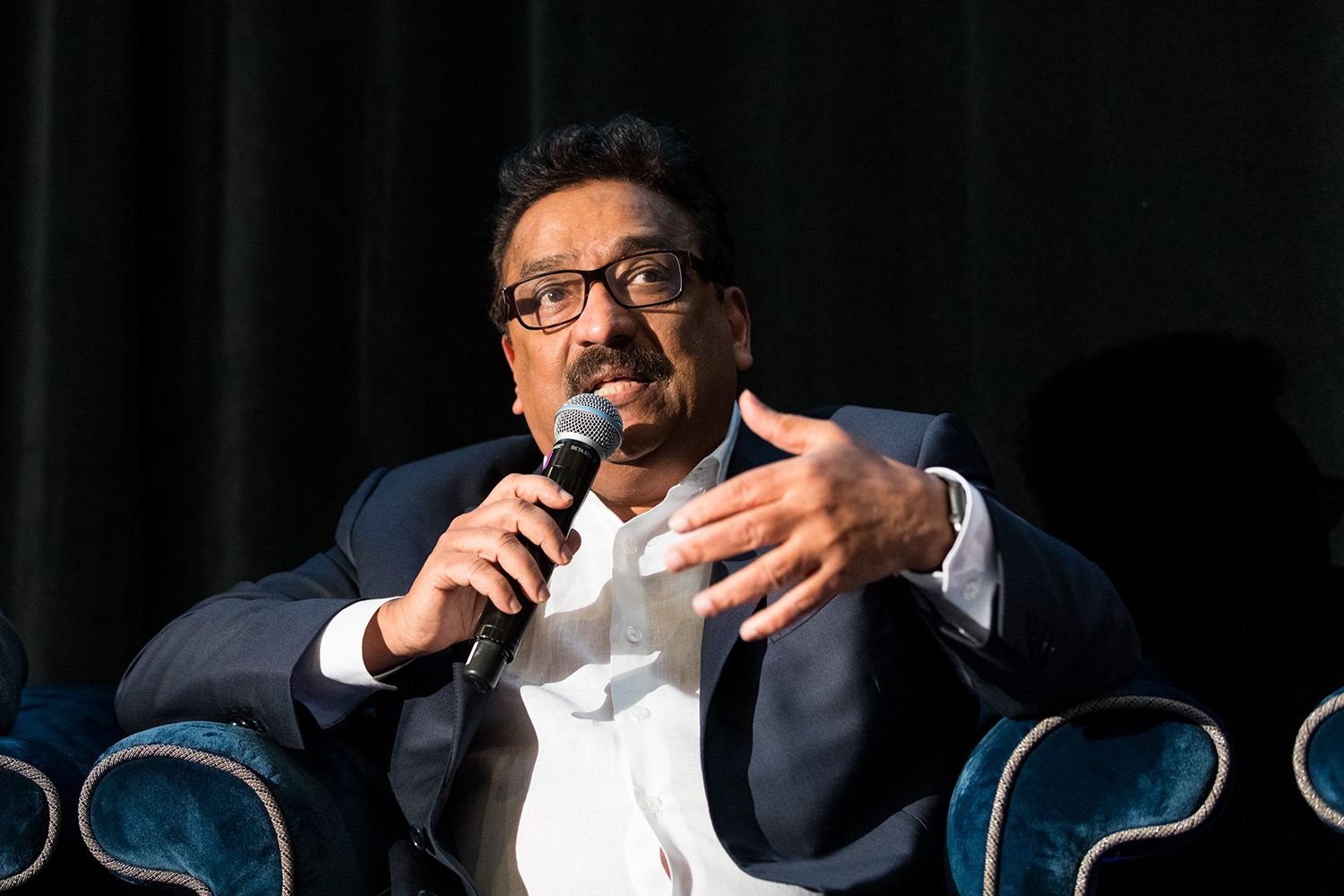
Jose Thomas, CEO of Choice Canning Co., emphasized that shrimp farmers in India need greater support as their challenges are mounting. Big corporate farmers have “never worked in Asia, particularly in India,” Thomas said, and the needs of the vast network of small producers in the country are “completely ignored.”
“Everyone tries to buy cheap. They have no crop insurance. Nobody lends them money. Middlemen charge an astronomical amount of interest. We should (collectively) provide them some comfort,” he said.
The challenges facing the farmed salmon sector are very different but still pressing, said Ragnar Nystøyl of Kontali, a Norway-based seafood data firm that annually contributes salmonid, sea bass and sea bream data to the annual report. Nystøyl said that Norway, after five years of growth and a “bumper year” in 2020, expects to see a 1 percent decline in production this year, and only 2.6 percent growth next year.
Nystøyl also touched upon a new tax proposal on Norwegian salmon producers that would increase the government tax on their profits from 22 percent to a stunning 62 percent. The proposal, which has roiled many of the industry’s leaders, comes during “the middle of the most important season for many importers and smokehouses,” said Nystøyl. Making matters even more complicated, the tax is scheduled to be applied on Jan. 1, 2023, but an official decision on the tax isn’t expected until Jan. 4.
With seafood prices rising in many categories, consumers are starting to feel the heat and are slowing their seafood purchases after a spike in retail sales in 2020 brought on by the Covid-19 pandemic. “Consumers have already begun to make some hard choices,” said Bob Cerullo of Wakefern Food Corp. “Many have decided that seafood was no longer an affordable option. Sales per unit are down dramatically.”
‘A bit of a mess’
Tom Pickerell, executive director of the Global Tuna Alliance, provided production and import-and-export trends for the key tuna species. Of the 15 tuna species distributed globally, catches and exports are mainly focused on just a handful, including skipjack, albacore, yellowfin, bigeye and bluefin.
Tuna harvest trends can be difficult to pin down. Pickerell noted that there are typically long periods of increases in catches, “then we try to undo the damage of overfishing. The rate of growth is decreasing. With gear types, some are up and some are down. It’s a bit of a mess,” he said.
The Western and Central Pacific accounts for 52 percent of the global tuna catch, said Pickerell, followed by the Indian Ocean (21 percent), Eastern Pacific (13 percent) and Atlantic Ocean (11 percent). The biggest factor driving export trends is tariffs. Thailand is by far the largest tuna supplier to the U.S. but is barely on the list of top suppliers to the EU market, which is dominated by Ecuador. “Tariffs for Ecuador to export the EU are significantly lower,” said Pickerell.
And while very few tuna stocks are considered overfished, Pickerell said that management is lacking in “almost all instances, except for North Atlantic albacore.
“A house with no roof – when the sun is shining it’s great, but when it rains you’re in trouble,” he said.
Be quick about it
Emily De Sousa, a fisheries scientist who uses social media platforms like Instagram and TikTok to bring sustainable seafood discussions to those with short attention spans, said time is of the essence if you’re targeting Millennials and Gen Z, which she said now have the “largest buying power in the market.”
Global seafood consumption is at an all-time high, she said, and that Millennials have increased their seafood consumption by 30 percent in the past year, as it’s the “perfect protein for young people,” she said.
“The food industry is currently experiencing a once-in-a-generation transition where consumers are actively shifting their eating habits toward lower-impact diets,” De Sousa said, and she delivered a number of tips for seafood companies thinking of making the plunge into marketing seafood on TikTok, currently the most popular social media app with those generations.
- Be authentic. “People want to connect with people, not businesses. Incorporate human elements. Content with faces increases engagement by 38 percent.”
- Be quick. “Social media users have short attention spans.”
- Make your point, quickly. “You have less than 2 seconds to convince someone to watch,” she said. So don’t build up to your point, with a lengthy introduction. State the conclusion first and then support it.
- Be clear. “Have a clear call to action in your content. Social media is a lot like talking to a 6-year-old. Don’t assume they know what you want them to do.”
- Be fun. “Get creative and let personality shine through. Where can you push the boundaries?”
- Share your why. “People don’t buy what you do. They buy why you do it.
“Seafood is not an easy industry to be in,” she said, but those companies can capitalize on their “greater purpose to be in this space.”
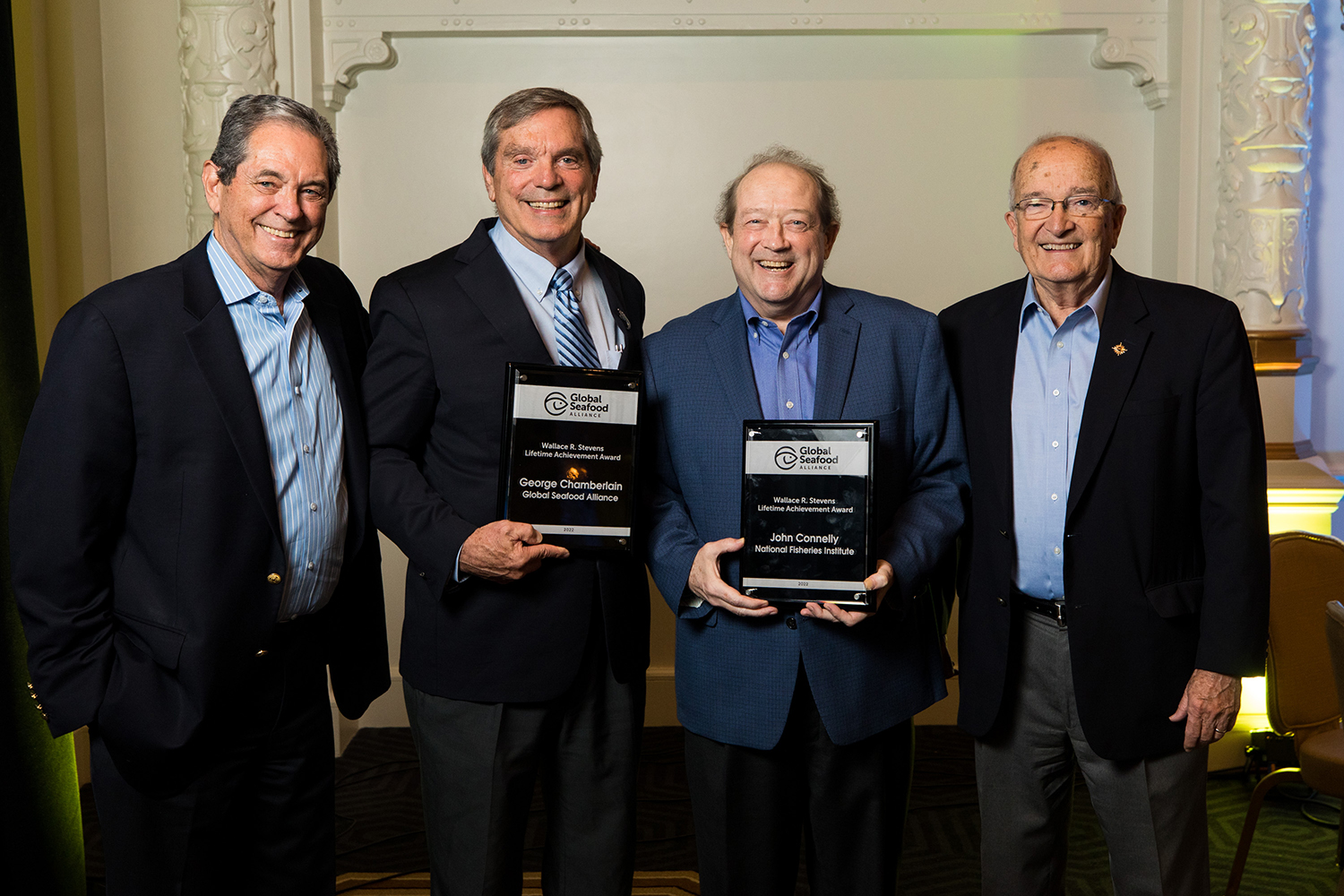
Lifetimes of achievement
GSA presented two Wallace R. Stevens Lifetime Achievement Awards, one to longtime National Fisheries Institute (U.S.) president John Connelly, who is retiring at the end of this year after a hugely successful 20-year run. Another was presented to GSA president and founder George Chamberlain, whose career in aquaculture spans more than four decades and who has been GSA president for the entire 25 years of the organization’s existence.
Both men were lauded for their leadership and longstanding commitments to bettering the industry. In emotional addresses, each thanked their peers, friends and families. Chamberlain’s wife and two sons and two daughters all joined him on stage to congratulate him on a life dedicated to responsible seafood. In 2023, Chamberlain will focus his efforts on education and advocacy through The Center for Responsible Seafood.
Gender justice
An afternoon breakout session sparked a spirited discussion about gender equality and barriers facing women and minorities in the seafood industry. Jeanne McKnight, industry veteran and executive director of the Northwest Aquaculture Alliance, kicked off the discussion by noting that the global seafood workforce is 50 percent women, who serve as the “backbone of the processing sector” in many areas of the world.
But women and minorities are underrepresented at higher levels, a fact that Julie Kuchepatov, founder of Seafood and Gender Equality (SAGE) believes can be corrected. For there to be greater equity and justice for women in seafood, a better grasp of the numbers of women working in fisheries and aquaculture is desperately needed.
“We can’t account for who we don’t count,” Kuchepatov said.
Imani Black founded the group Minorities in Aquaculture (MIA) in 2020 after working for six years as a commercial oyster farmer in Maryland. She started MIA simply to find other women of color in aquaculture to build a community, but the effort has become more of an educational, training and mentorship program that will prepare women and men of color to be ready for jobs in aquaculture.
“Various demographics not being engaged with wholeheartedly,” she said. “We have done things from an intentional and impactful minority engagement approach. It doesn’t take much to be impactful.”
“It’s hard to envision yourself in a career when you don’t see anybody doing it who looks like you,” said Kuchepatov, who also launched her organization in 2020 at the onset of the Covid-19 pandemic. Seafood can benefit from other industries, she added: “A lot of sectors have gone through this exercise. Precompetitive collaborations are a successful model in seafood. We need high-level leadership to rally around the issue, develop tools [for buyers] and align on commitments to drive change.”
Follow the Advocate on Twitter @GSA_Advocate
Now that you've reached the end of the article ...
… please consider supporting GSA’s mission to advance responsible seafood practices through education, advocacy and third-party assurances. The Advocate aims to document the evolution of responsible seafood practices and share the expansive knowledge of our vast network of contributors.
By becoming a Global Seafood Alliance member, you’re ensuring that all of the pre-competitive work we do through member benefits, resources and events can continue. Individual membership costs just $50 a year.
Not a GSA member? Join us.
Author
-
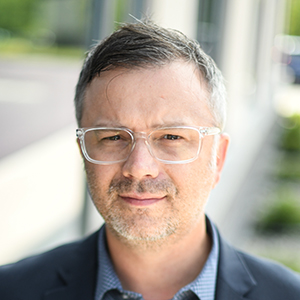
James Wright
Editorial Manager
Global Seafood Alliance
Portsmouth, NH, USA[103,114,111,46,100,111,111,102,97,101,115,108,97,98,111,108,103,64,116,104,103,105,114,119,46,115,101,109,97,106]
Tagged With
Related Posts
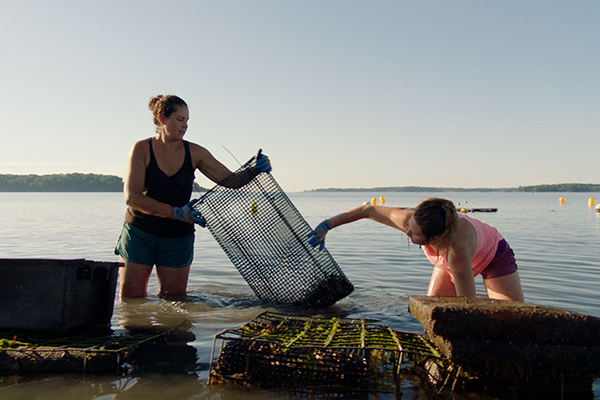
Responsibility
‘Walk in like you own the place’: How inequality continues to impact women in aquaculture and the obstacles to change
The Women in North American Aquaculture Summit examined equal opportunity for women in aquaculture, barriers to participation and inequality solutions.
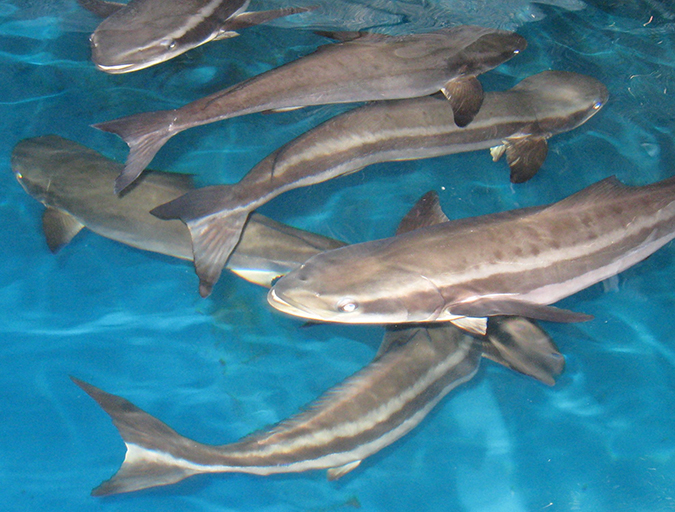
Intelligence
Global Farmed Finfish Production Outlook: Slower-paced growth
The GOAL 2016 survey for global production of farmed fish shows that most major finfish groups increased their farmed production in 2015. The total production of species and countries covered by the survey is forecasted to reach 42 MMT in 2016.
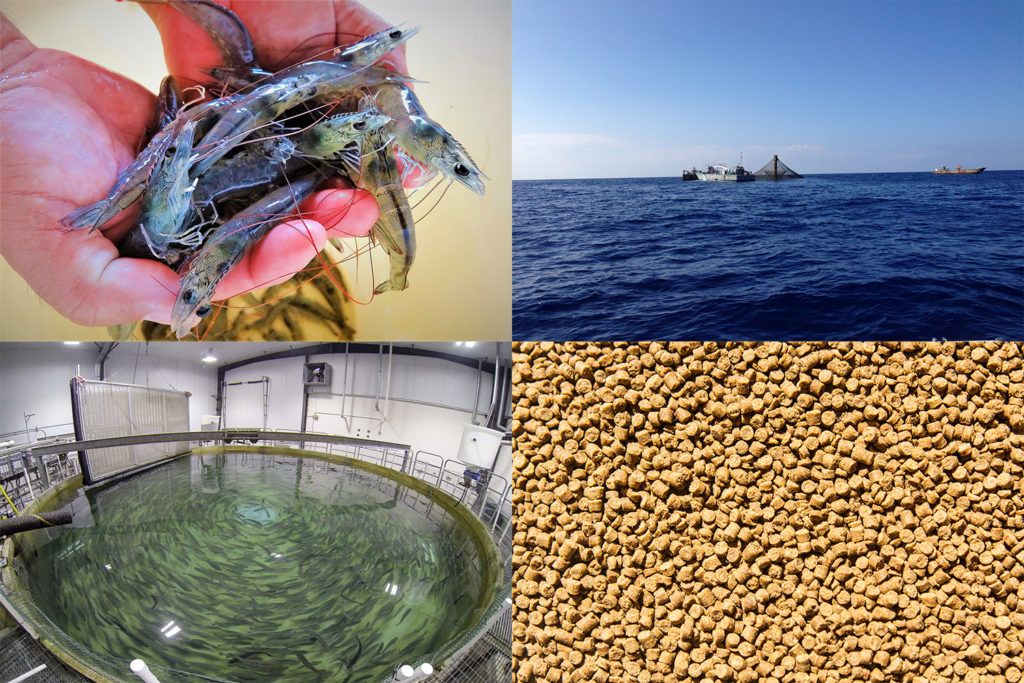
Innovation & Investment
Aquaculture is winning, Rabobank analyst explains
Aquaculture is the “winning protein,” according to a new Rabobank report that its author, Gorjan Nikolik, said is intended to draw the bank’s agro-industry clients to opportunities in the fish farming business.
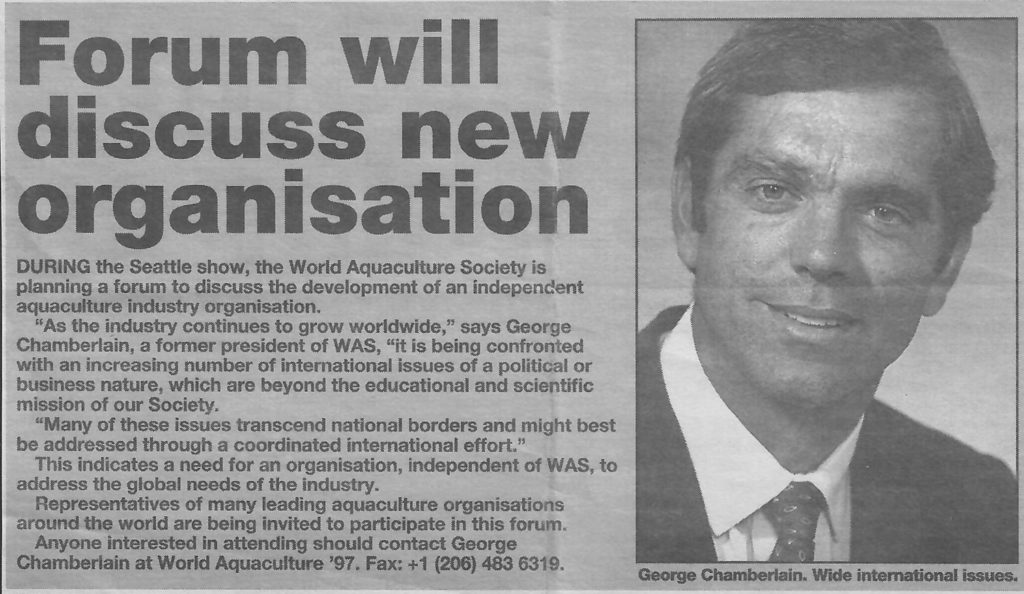
Innovation & Investment
20 years of the Global Aquaculture Alliance
A timeline of key milestones and achievements by the Global Aquaculture Alliance and its third-party aquaculture certification scheme, Best Aquaculture Practices (BAP).


